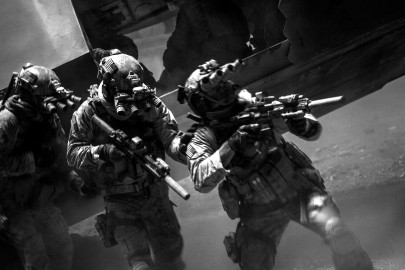The hunt for Bin Laden through Hollywood’s eyes

Gina Scialabba
The Guardsman
Go see “Zero Dark Thirty.” You know you want to. All your friends are already doing it.
Everyone is talking about it.
Calif. Sen. Diane Feinstein is talking about it. She wants an investigation into the CIA’s contributions to the film.
Anti-torture protesters are talking about it. They’re standing outside theaters, demanding U.S. accountability.
Friends and colleagues are talking about it. They want to know whether CIA agent Maya, portrayed by the passionately convincing Jessica Chastain, is based upon a real or composite character.
Finally, the Academy of Motion Pictures Arts and Sciences is talking about it. They just nominated it for Best Picture of the Year.
So, what’s all the hype? How has this little reel of celluloid with a cryptic title and cast of relative unknowns, save Chastain, suddenly attracted international acclaim and criticism?
Part of the “hype” is personal.
The movie follows a decade of living history in this country that has touched all our lives. Who doesn’t remember where they were when the World Trade Center collapsed?
The film, directed by Academy Award winner Kathryn Bigelow of “The Hurt Locker” fame, revolves around one simple fact: Bin Laden is dead. That’s common knowledge.
Yet the events leading up to his capture and ultimate demise are still largely unknown. Bigelow attempts to give viewers the true back story behind the raid, and how the CIA connected the dots that eventually led them to the target.
Bin Laden wasn’t holed up in a dusty cave community, a C-4 explosive belt strapped to his gaunt body awaiting American “infidels.”
The most hated man in the world, responsible for the murder of over 3,000 people in the 9/11 attacks, was killed May 2, 2011, by U.S. Navy Seals in the middle of Abbottabad, Pakistan.
Bin Laden was surrounded by women and children. Tribal elders and loyal lieges were not by his side, ready to complete their “Jihad.”
His assassins, “the canaries,” came quietly in the night, or rather loudly if you follow the film’s version of events, including a helicopter dramatically crashing in the terrorist’s front yard.
Astonishingly, his hiding place was a large compound in a suburban city of one million people, less than a mile away from Pakistan’s equivalent to West Point.
Did I just give away the end of the movie? Hardly.
Everyone knows how this story ends. It is not the end of Bigelow’s movie that grips us so much as the murky details leading up to one somewhat anticlimatic death.
Bin Laden was shot and killed before the Seals knew it was him.
Bigelow masterfully plays this period out in a slow, methodical way. Most of the movie takes place in CIA offices and cubicles. Suspense builds bit by sordid bit.
Her account of Bin Laden’s pursuit and capture is vivid and takes the viewer onto the front lines of this mission.
But, how accurate is it?
Bigelow has clearly stated she and screenwriter Mark Boal consulted with the CIA in making the movie. So, is this CIA propaganda masquerading as semifiction?
You be the judge.
The most chilling scenes come at you immediately.
The movie opens with a black screen and voices from the victims trapped in the twin towers. An emotional tug at our heartstrings.
It then moves into 45 minutes of torture scenes involving waterboarding, a human dog collar and a combination of physical and psychological abuse.
Only after the detainee is threatened with more torture does he divulge the name of Bin Laden’s personal courier.
Was this type of brutal torture necessary for us to locate the elusive Bin Laden? The movie seems to say yes.
Feinstein, Sen. John McCain and others call the film “misleading” in its depiction of the graphic and brutal torture techniques to make “enemy combatants” talk.
Others are convinced the waterboarding scenes are indicative of a United States that sees torture as necessary for its own defense.
Despite all the controversy, this is an important movie that is sparking a serious dialogue about torture in American wartime policies.
If you go, be prepared for a linear view of the good guys (read: Americans) and the bad guys (anyone not-American), as well as a lack of any meaningful discussion about the Muslim world.

Comments are closed.